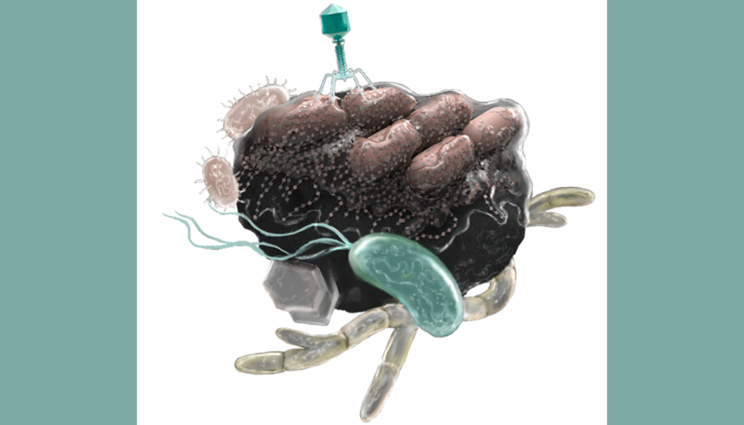The hidden symphony of soil: decoding viral dynamics and microbial mortality after the first rainfall
 (Download Image)
(Download Image)
A single virus on top of bacterial cells in extracellular polymeric substance and other bacteria and fungal hyphae attached to a soil aggregate. Image by Victor Leshyk/Northern Arizona University.
Soil is a highly complex microbial habitat that is home to tens of millions of microbial populations, where biotic and abiotic factors shape microbial community structure. Moments of acute pressure on a community, such as rapid environmental changes or fluxes in resource availability, drive successional trajectories that result in altered community structures. One such example is the first rainfall following the dry season, known as “wet-up.” However, the ecology, lifestyle, and impact of viruses in the soil microbiome during such dynamic moments remains unknown.
To address this gap in knowledge, a collaborative research team used analytical techniques—time-resolved viromics and quantitative stable isotope probing (qSIP) targeted metagenomics—to understand lineage-specific viral-host temporal patterns following rewetting, and how viruses restructure the soil microbiome and contribute to cell death and carbon mineralization. In arid soils, abundant extracellular DNA and dormant cells can mask active microbial populations, since up to 75% of cells may be inactive at any given time in soil. However, qSIP allows researchers to directly identify active microbes by tracing a stable isotope (18O via H218O) into the DNA of microbes and viruses actively replicating in response to rewetting.
The results indicate that dry soil holds a diverse but low biomass reservoir of virions, of which only a subset thrives following wet-up. Additionally, viral richness was found to decrease by 50% within 24-hours post wet-up, while viral biomass increases four-fold within one week. The team also estimates that viruses drive a measurable and continuous rate of cell lysis (i.e., death), with up to 46% of microbial death driven by viral lysis one week following wet-up. Thus, viruses contribute to turnover of soil microbial biomass and the widely reported CO2 efflux following wet-up of seasonally dry soils.
While these findings indicate viruses may not be the primary mechanism of observed mortality, viruses appear to play an important and dynamic role in the microbial response following wet-up. Overall, this study provides a first glimpse into fine spatiotemporal viral dynamics in soil and enabled researchers to categorize distinct viral responses to rewetting.
[A.M. Nicolas, E.T. Sieradzki, J. Pett-Ridge, J.F. Banfield, M.E. Taga, M.K. Firestone, S.J. Blazewicz, A subset of viruses thrives following microbial resuscitation during rewetting of a seasonally dry California grassland soil, Nature Communications (2023), DOI: 10.1038/s41467-023-40835-4.]
–Physical and Life Sciences Communications Team







